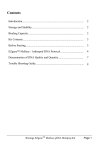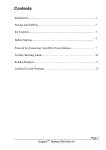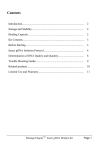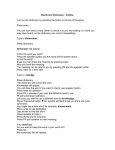Download E.Z.N.A.®Mollusc DNA Kit - Omega Bio-Tek
Transcript
E.Z.N.A.® Mollusc DNA Kit
D3373-00
5 preps
D3373-01
50 preps
D3373-02
200 preps
May 2013
E.Z.N.A.® Mollusc DNA Kit
Table of Contents
Introduction...................................................................................2
Kit Contents/Storage and Stability.........................................3
Determination of DNA Quality and Quantity....................3
Preparing Reagents.......................................................................4
Mollusc DNA Kit Protocol...........................................................5
Troubleshooting Guide.............................................................10
Ordering..........................................................................11
Manual Revision : May 2013
Innovations in nucleic acid isolation
1
Introduction
The E.Z.N.A.® Mollusc DNA Kit is designed for efficient recovery of genomic DNA up
to 60 kb in size from molluscs, insects, arthropods, roundworms, flatworms, and other
invertebrate tissue samples rich in mucopolysaccharides. The method is suitable for
invertebrates frozen or preserved in alcohol or DNE solution, and good results can be
obtained with formalin preserved material.
The procedure relies on the well established properties of the cationic detergent,
cetyltrimethyl ammonium bromide (CTAB), in conjunction with the selective DNA binding
of Omega Bio-tek’s HiBind® matrix. Samples are homogenized and lysed in a high salt
buffer containing CTAB and extracted with chloroform to remove mucopolysaccharides.
Binding conditions are adjusted and DNA further purified using HiBind® DNA spin
columns. In this way, salts, proteins and other contaminants are removed to yield
high-quality genomic DNA suitable for downstream applications such as endonuclease
digestion, thermal cycle amplification, and hybridization techniques.
New in this Edition:
•
•
•
2
HB Buffer has been replaced by HBC Buffer. Isopropanol is required and supplied by
the user.
Equilibration Buffer is no longer included with this kit. An optional Column
Equilibration Protocol has been added to the protocol for your convenience.
Equilibration Buffer is replaced with 3M NaOH provided by the user.
Kit Contents
Product
HiBind® DNA Mini Columns
2 mL Collection Tubes
D3373-00
D3373-01
D3373-02
5
50
200
10
100
400
ML1 Buffer
3 mL
30 mL
125 mL
MBL Buffer
5 mL
20 mL
80 mL
HBC Buffer
4 mL
25 mL
80 mL
Proteinase K Solution
150 µL
1.5 mL
6.0 mL
RNase A
55 μL
520 μL
2.1 mL
DNA Wash Buffer
1.5 mL
15 mL
3 x 25 mL
Elution Buffer
1 mL
20 mL
50 mL
User Manual
1
1
1
Storage and Stability
All components of the E.Z.N.A.® Mollusc DNA Kit, except the RNase A should be stored at
22-25°C. Proteinase K Solution can be stored at room temperature for 12 months. For
long term store (>12 months) store at 2-8°C. Store RNase A at 4°C. Under these conditions,
DNA has successfully been purified and used for PCR after 12 months of storage. During
shipment, or storage in cool ambient conditions, precipitates may form in some buffers. It
is possible to dissolve such deposits by heating the solution at 65°C.
Determination of DNA Quality and Quantity
Dilute a portion of the eluted material approximately 10-20 fold in DNA Elution Buffer or
10 mM Tris, pH 8.5. Measure absorbance at 280 nm and at 260 nm to determine the A260/
A280 ratio. Values of 1.7-1.9 generally indicate 85%-90% purity. The concentration of DNA
eluted can be determined as follows:
Concentration = 50 μg/mL x Absorbance260 x {Dilution Factor}
3
Preparing Reagents
1.
2.
4
Dilute DNA Wash Buffer with 100% ethanol as follows and store at room temperature.
Kit
100% Ethanol to be Added
D3373-00
6 mL
D3373-01
60 mL
D3373-02
100 mL per bottle
Dilute HBC Buffer with isopropanol as follows and store at room temperature.
Kit
Isopropanol to be Added
D3373-00
1.6 mL
D3373-01
10 mL
D3373-02
32 mL
E.Z.N.A.® Mollusc DNA Kit Protocol
E.Z.N.A.® Mollusc DNA Protocol
Invertebrates preserved in formalin should be rinsed in xylene and then ethanol before
processing. Note that results obtained with formalin-fixed tissues generally depend on
age and size of specimen. Purified material is usually adequate for PCR amplification, but
fresh or frozen samples should be used for Southern analyses.
Materials and Equipment to be Supplied by User:
•
•
•
•
•
•
Microcentrifuge capable of at least 10,000 x g
Nuclease-free 1.5 mL or 2 mL microcentrifuge tubes
Water baths capable of 60°C and 70°C
Vortexer
100% ethanol
Chloroform:isoamyl alcohol (24:1)
Before Starting:
•
•
•
Prepare buffers according to the instructions on Page 4
Set water baths to 60°C and 70°C
Heat Elution Buffer to 70°C
1.
Homogenize tissue sample following one of the procedures below depending on the
sample type.
A.Arthropods
1. Pulverize no more than 50 mg of tissue in liquid nitrogen with a mortar and
pestle.
Note: If ceramic mortar and pestle are not available, homogenize the sample in
the microcentrifuge tube using a disposable microtube pestle (Omega Bio-tek,
Cat No. SSI-1015-39; Eppendorf, Cat No. 0030 120.973; VWR, Cat No. KT 7495200000).
2.
Transfer the powder to a clean 1.5 mL microcentrifuge tube.
3.
Proceed to Step 2 below.
5
E.Z.N.A.® Mollusc DNA Kit Protocol
B.
Molluscs (and other soft tissue invertebrates)
1.
Pulverize no more than 30 mg tissue in liquid nitrogen with a mortar and
pestle.
2.
Transfer the powder to a clean 1.5 mL microcentrifuge tube.
Note: If ceramic mortar and pestle are not available, homogenize the
sample in the microcentrifuge tube using a disposable microtube pestle
(Omega Bio-tek, Cat No. SSI-1015-39; Eppendorf, Cat No. 0030 120.973;
VWR, Cat No. KT 749520-0000). Addition of a pinch of white quartz sand, -50
to 70 mesh (Sigma Chemical Co. Cat No. S9887) will help.
3.
Proceed with Step 2 below.
Note: The amount of starting material depends on the sample and can be increased if
acceptable results are obtained with the suggested 30 mg tissue. For easy-to-process
specimens, the procedure may be scaled up and the buffer volumes used increased in
proportion. In any event, use no more than 50 mg tissue per HiBind® DNA Mini Column
as binding capacity (100 μg) may be exceeded. Meanwhile, difficult tissues may require
starting with less than 30 mg tissue and doubling all volumes to ensure adequate lysis.
2.
Add 350 μL ML1 Buffer and 25 μL Proteinase K Solution. Vortex to mix thoroughly.
3.
Incubate at 60°C for a minimum of 30 minutes or until entire sample is solubilized.
Note: Actual incubation time varies and depends on the elasticity of the tissue. Most
samples require no more than 4 hours. Alternatively an overnight incubation at 37°C
will produce adequate results.
4.
Add 350 μL chloroform:isoamyl alcohol (24:1). Vortex to mix thoroughly.
5.
Centrifuge 10,000 x g for 2 minutes at room temperature.
6
E.Z.N.A.® Mollusc DNA Kit Protocol
6.
Transfer the upper aqueous phase to a clean 1.5 mL microcentrifuge tube. Avoid the
milky interface containing contaminants and inhibitors.
Note: This step will remove much of the polysaccharides and proteins from solution
and improve spin-column performance downstream. If a small upper aqueous phase
is present after centrifugation, add 200 μL ML1 Buffer and vortex to mix thoroughly.
Repeat Step 5 (centrifugation) and Step 6 (transfer the upper aqueous phase).
7.
Add one volume MBL Buffer and 10 μL RNase A. Vortex at maximum speed for 15
seconds.
Note: For example, to 500 μL upper aqueous solution from Step 6, add 500 μL MBL
Buffer.
8.
Incubate at 70°C for 10 minutes.
9.
Cool the sample to room temperature.
10. Add one volume 100% ethanol. Vortex at maximum speed for 15 seconds.
Note: For example, to 500 μL upper aqueous solution from Step 6, add 500 μL 100%
ethanol.
11. Insert a HiBind® DNA Mini Column into a 2 mL Collection Tube.
Optional Protocol for Column Equilibration:
1.
2.
3.
Add 100 µL 3M NaOH to the HiBind® DNA Mini Column.
Centrifuge at maximum speed for 60 seconds.
Discard the filtrate and reuse the collection tube.
12. Transfer 750 µL sample from Step 9 (including any precipitate that may have formed)
to the HiBind® DNA Mini Column.
13. Centrifuge at 10,000 x g for 1 minute.
7
E.Z.N.A.® Mollusc DNA Kit Protocol
14. Discard the filtrate and reuse the collection tube.
15. Repeat Steps 12-14 until all of the sample has been applied to the HiBind® DNA Mini
Column.
16. Discard the filtrate and the Collection Tube.
17. Insert the HiBind® DNA Mini Column into a new 2 mL Collection Tube.
18. Add 500 μL HBC Buffer.
Note: HBC Buffer must be diluted with isopropanol before use. Please see Page 6 for
instructions.
19. Centrifuge at 10,000 x g for 30 seconds.
20. Discard the filtrate and reuse the Collection Tube.
21. Add 700 μL DNA Wash Buffer.
Note: DNA Wash Buffer must be diluted with 100% ethanol prior to use. Please refer
to Page 4 or the bottle label for instructions.
22. Centrifuge at 10,000 x g for 1 minute.
23. Discard the filtrate and reuse the Collection Tube.
24. Repeat Steps 21-235 for a second DNA Wash Buffer wash step.
25. Centrifuge the empty HiBind® DNA Mini Column at maximum speed for 2 minutes to
dry the membrane.
Note: It is critical to remove any trace of ethanol that may otherwise interfere with
downstream applications.
8
E.Z.N.A.® Mollusc DNA Kit Protocol
26. Transfer the HiBind® DNA Mini Column to a nuclease-free 1.5 or 2 mL microcentrifuge
tube (not provided).
27. Add 50-100 μL Elution Buffer (or sterile deionized water) preheated to 70°C.
Note: Smaller elution volumes will increase DNA concentration but decrease yield.
Elution volumes greater than 200 μL are not recommended.
28. Let sit at room temperature for 2 minutes.
29. Centrifuge at 10,000 x g for 1 minute.
30. Repeat Steps 27-29 for a second elution step.
Note: Any combination of the following steps can be used to help increase DNA yield.
•
•
•
•
After adding the Elution Buffer, incubate the column for 5 minutes.
Increase the elution volume.
Repeat the elution step with fresh Elution Buffer (this may increase the yield, but
decrease the concentration).
Repeat the elution step using the eluate from the first elution (this may increase
yield while maintaining elution volume).
31. Store DNA at -20°C.
9
Troubleshooting Guide
Please use this guide to troubleshoot any problems that may arise. For further assistance,
please contact the technical support staff , toll free, at (800-832-8896).
Problem
Clogged
Column
Low DNA
yield
Cause
Solution
Incomplete lysis
Increase incubation time with ML1 Buffer/
Proteinase K Solution. An overnight incubation
may be necessary.
Sample too large
Do not use greater than the recommended
amount of starting material. For larger samples,
divide into multiple tubes.
Incomplete
homogenization
Pulverize material as indicated in liquid nitrogen
to obtain a fine powder.
Clogged column
See above
Poor elution
Repeat elution or increase elution volume.
Incubate the column at 70°C for 5 minutes
before centrifugation.
Poor binding to column
Follow the protocol closely when adjusting the
binding conditions.
Improper washing
DNA Wash Buffer must be diluted with 100%
ethanol before use.
Extended centrifugation
during elution step
Resin from the column may be present in eluate.
Avoid centrifugation at speeds higher than
specified. The material can be removed from the
eluate by centrifugation; it will not interfere with
PCR or restriction digests.
Low DNA
Yield or
no DNA
DNA washed off
Yield
No DNA
eluted
10
Repeat the DNA isolation, be sure to thoroughly
mix the sample with ML1 Buffer.
Trace protein
contaminants remain
Following Step 19, wash column with a mixture
of 300 μL MBL Buffer and 300 μL ethanol before
proceeding to Step 20.
Poor cell lysis
Increase incubation time with ML1 Buffer. An
overnight incubation may be necessary.
Incomplete
homogenization
Pulverize starting material as indicated in liquid
nitrogen to obtain a fine powder.
100% ethanol was not
added before adding
sample to column
Before applying DNA sample to column, add
MBL Buffer and 100% ethanol.
Ethanol was not added
to the DNA Wash Buffer
Dilute DNA Wash Buffer with the indicated
volume of 100% ethanol before use.
Isopropanol was not
added to the HBC Buffer
Dilute HBC Buffer with the indicated volume of
isopropanol before use.
Ordering Information
The following components are available for purchase separately.
(Call Toll Free at 1-800-832-8896)
Product
HiBind® DNA Mini Columns, 200 columns
RNAse A, 5 mL
Part Number
DNACOL-02
PD090
Proteinase K Solution
AC116
Elution Buffer, 100 mL
PDR048
DNA Wash Buffer, 100 mL
PS010
HiBind®, E.Z.N.A.®, and MicroElute® are registered trademarks of Omega Bio-tek, Inc.
PCR is a patented process of Hoffman-La Roche. Use of the PCR process requires a license.
11
Notes:
12































